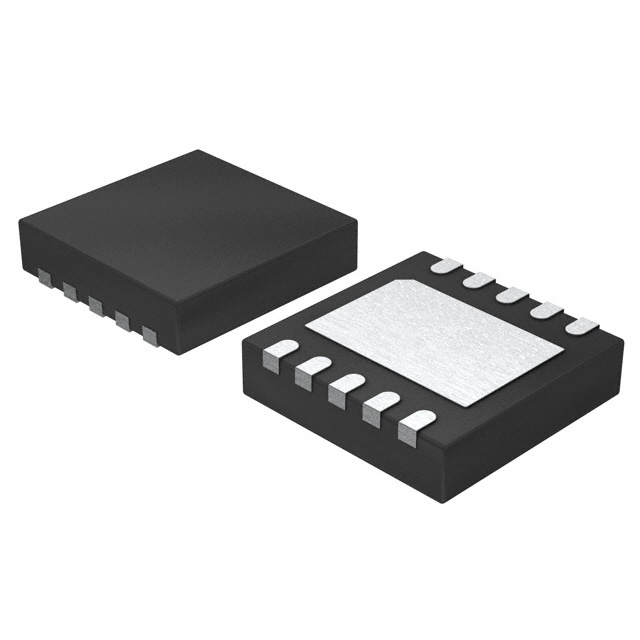LTC2616CDD-1#PBF
Product Overview
Category
The LTC2616CDD-1#PBF belongs to the category of digital-to-analog converters (DACs).
Use
This product is primarily used in applications where a digital signal needs to be converted into an analog voltage or current.
Characteristics
- High precision: The LTC2616CDD-1#PBF offers high-resolution and low integral nonlinearity, ensuring accurate conversion of digital signals.
- Low power consumption: This DAC operates at low power levels, making it suitable for battery-powered devices.
- Wide operating voltage range: The LTC2616CDD-1#PBF can operate within a wide voltage range, providing flexibility in various applications.
- Fast settling time: With its fast settling time, this DAC enables quick and efficient conversion of digital signals.
Package
The LTC2616CDD-1#PBF is available in a compact dual 10-lead DFN package.
Essence
The essence of the LTC2616CDD-1#PBF lies in its ability to accurately convert digital signals into analog voltages or currents with high precision and low power consumption.
Packaging/Quantity
This product is typically packaged in reels and is available in quantities specified by the manufacturer.
Specifications
- Resolution: 16 bits
- Number of channels: 1
- Supply voltage range: 2.7V to 5.5V
- Output voltage range: 0V to VREF
- Operating temperature range: -40°C to 85°C
- Interface: SPI-compatible
Detailed Pin Configuration
The LTC2616CDD-1#PBF has the following pin configuration:
- VDD: Power supply voltage
- GND: Ground
- CS: Chip select input
- SCK: Serial clock input
- SDI: Serial data input
- LDAC: Load DAC input
- REF: Reference voltage input
- VOUT: Analog output
- AGND: Analog ground
- VREF: Reference voltage output
Functional Features
- High-resolution digital-to-analog conversion
- Low integral nonlinearity for accurate analog output
- SPI-compatible interface for easy integration with microcontrollers and other digital systems
- Fast settling time for efficient signal conversion
- Power-down mode for reduced power consumption when not in use
Advantages and Disadvantages
Advantages
- High precision and accuracy in converting digital signals to analog voltages or currents
- Low power consumption, making it suitable for battery-powered devices
- Wide operating voltage range provides flexibility in various applications
- Compact package size for space-constrained designs
- Fast settling time enables quick and efficient conversion of digital signals
Disadvantages
- Limited to a single channel output
- Requires an external reference voltage for operation
Working Principles
The LTC2616CDD-1#PBF operates by receiving digital input signals through the SPI interface. These digital signals are then converted into corresponding analog voltages or currents using high-resolution digital-to-analog conversion techniques. The resulting analog output can be used in various applications such as audio processing, instrumentation, and control systems.
Detailed Application Field Plans
The LTC2616CDD-1#PBF finds application in a wide range of fields, including:
- Audio Processing: This DAC can be used in audio equipment to convert digital audio signals into analog voltages for amplification and playback.
- Instrumentation: The LTC2616CDD-1#PBF is suitable for precision measurement instruments that require accurate analog outputs.
- Control Systems: It can be utilized in control systems to generate analog control signals for motor control, robotics, and industrial automation.
Detailed and Complete Alternative Models
- LTC2616IDD-1#PBF: Similar to the LTC2616CDD-1#PBF, but available in a compact 10-lead MSOP package.
- LTC2616HDD-1#PBF: Higher resolution variant with 18-bit digital-to-analog conversion capability.
- LTC2616CDD-2#PBF: Dual-channel version of the LTC2616CDD-1#PBF, providing two independent analog outputs.
These alternative models offer similar functionality and can be considered based on specific application requirements.
In conclusion, the LTC2616CDD-1#PBF is a high-precision digital-to-analog converter that offers accurate conversion of digital signals into analog voltages or currents. With its low power consumption, wide operating voltage range, and fast settling time, it is suitable for various applications in audio processing, instrumentation, and control systems. While it has some limitations such as a single channel output and the need for an external reference voltage, alternative models are available to cater to
Lista 10 Vanliga frågor och svar relaterade till tillämpningen av LTC2616CDD-1#PBF i tekniska lösningar
Sure! Here are 10 common questions and answers related to the application of LTC2616CDD-1#PBF in technical solutions:
Q1: What is LTC2616CDD-1#PBF? A1: LTC2616CDD-1#PBF is a specific model of digital-to-analog converter (DAC) manufactured by Linear Technology. It is designed to convert digital signals into analog voltages.
Q2: What is the resolution of LTC2616CDD-1#PBF? A2: LTC2616CDD-1#PBF has a resolution of 16 bits, which means it can represent 2^16 (65,536) different voltage levels.
Q3: What is the operating voltage range of LTC2616CDD-1#PBF? A3: The operating voltage range of LTC2616CDD-1#PBF is typically between 2.7V and 5.5V.
Q4: How many channels does LTC2616CDD-1#PBF have? A4: LTC2616CDD-1#PBF has 1 channel, meaning it can output a single analog voltage.
Q5: What is the maximum output voltage range of LTC2616CDD-1#PBF? A5: The maximum output voltage range of LTC2616CDD-1#PBF is typically between 0V and Vref, where Vref is the reference voltage supplied to the DAC.
Q6: Can LTC2616CDD-1#PBF be controlled using a microcontroller? A6: Yes, LTC2616CDD-1#PBF can be controlled using a microcontroller through an interface such as I2C or SPI.
Q7: Is LTC2616CDD-1#PBF suitable for precision applications? A7: Yes, LTC2616CDD-1#PBF is suitable for precision applications as it offers low integral nonlinearity (INL) and differential nonlinearity (DNL).
Q8: What is the power consumption of LTC2616CDD-1#PBF? A8: The power consumption of LTC2616CDD-1#PBF depends on various factors such as the operating voltage and output load, but it typically consumes low power.
Q9: Can LTC2616CDD-1#PBF be used in industrial environments? A9: Yes, LTC2616CDD-1#PBF can be used in industrial environments as it is designed to operate reliably in a wide temperature range and is resistant to environmental factors.
Q10: Are there any evaluation boards or development kits available for LTC2616CDD-1#PBF? A10: Yes, Linear Technology provides evaluation boards and development kits that can be used to test and prototype with LTC2616CDD-1#PBF. These tools help simplify the integration process into technical solutions.
Please note that the answers provided here are general and may vary depending on specific datasheet specifications and application requirements.


